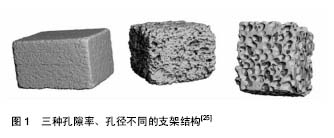2.1 骨性结合与骨 不同部位的假体植入物对其设计有着不同的要求,如在全髋关节置换中,球头部分的假体植入物需要良好的耐磨能力,而与宿主骨组织直接接触的股骨柄及臼杯外面则需要良好的骨性结合能力。本文研究假体植入物多级孔结构的设计,也正式针对需要与宿主骨产生骨性结合的假体植入物。骨性结合指的是宿主骨组织可以“长入”假体植入物其内部,与传统的机械形式的固定不同,骨性结合使得宿主骨与植入物接触面没有了生硬的“交接”,取而代之的是一种“过渡”。在原有摩擦力的基础上,骨组织长入支架表面的孔隙结构之中,与单纯依靠宿主骨与植入物之间摩擦力的固定方式相比,这种骨性结合更加稳定
[2]。而为了设计出能与宿主骨产生良好骨性结合的假体植入物,首先必须充分认识自然状态下的骨。
骨是一种由羟基磷灰石晶体在有机基质上沉积形成的组织[3]。在形态学方面,骨由骨小梁组成,骨小梁之间相互联结,形成一种多孔的松质骨,孔隙率在50%-90%,孔隙的直径大为1 mm,而较为致密的皮质骨围绕其外[4]。皮质骨有着固体孔多的结构,比如说哈佛氏管,横断面面积约为2 500-12 000 μm2,使得皮质骨孔隙率在3%-12%[5]。在细胞学方面,骨组织内主要存在4种细胞:成骨细胞、破骨细胞、骨细胞和骨衬里细胞。成骨细胞制造、矿化新的骨基质,骨细胞保持着基质,而破骨细胞吸收基质。骨衬里细胞则是一种非活跃细胞,被认为是成骨细胞的前体。在骨组织工程学方面,成骨的是一个复杂、动态的过程[6-8]:将要成骨的部位首先毛细血管增生,随之骨髓干细胞迁移和募集于此;骨组织内特殊的蛋白质和胶原,有特殊的缩氨酸序列,可以使骨髓干细胞分化成为造骨细胞;造骨细胞一方面分泌胶质原形成骨基质,另一方面聚集钙元素,形成羟基磷灰石结晶;这些羟基磷灰石结晶可以生长、排列在胶质原形成的螺旋状骨基质蛋白质之上,使骨基质矿化,形成骨小梁;而在成骨细胞成骨的同时,破骨细胞也在对骨组织进行分解、吸收,成骨与破骨之间互相作用,使骨组织不断地生长和改建,以形成不同的结构,适应不同功能上的需求。
纵观成骨的整个过程,可以发现血管的生成、骨髓干细胞的迁移与定植、骨基质的形成、骨基质的矿化,每一步都对成骨至关重要。而若想使支架与宿主骨产生骨性结合,则需要设计的支架可以满足成骨过程中每一步的所需的要求。
2.2 支架的属性与骨整合能力 为了更好地研究假体植入物设计方案,研究者在实验室中创造较小的“支架”,可以将其看作是缩小的假体植入物,而后再进行相应体内或体外试验。而支架对骨性结合的促进作用,人们采用“骨整合”能力评价。术语“骨整合”的首次使来于Branemark,为了描述钛支架与组织稳定固定的情形[9]。
一个骨整合能力强的支架应具有良好的生物相容性、适于骨长入的结构。支架的各种属性都与其骨整合能力紧密相连,诸如支架材料、支架机械特征、支架携带的各种生长因子或经修饰的支架表面特性等。
一个理想的支架必须在以下几点满足要求。首先,支架应有良好的生物相容性,即支架应能正常支持细胞活性的能力,且不对宿主组织产生毒副作用,而支架的生物相容性很大程度上取决于支架的材料。支架材料一直是该领域国内外研究的重点,磷酸钙陶瓷材料、可降解生物玻璃材料、高分子聚合材料(如多聚乳酸、聚己内酯等)、复合材料、金属材料等已被大量实验所研究。其次,支架应具用一定的机械强度,并且只有在满足机械强度要求的前提下,支架结构的研究才是有意义的。最后,支架应具有多孔的特征,虽然不同用途的假体植入物不一定需要具备多孔结构,但研究骨长入的支架应具备多孔,一方面多孔给宿主骨的长入提供了空间,另一方面多孔结构还可以配合可降解凝胶的物质方便支架携带各种生长因子。
针对支架材料、生长因子、表面改性的研究一直是国内外相关领域的热点,除了针对生物相容性方面的材料种类、材料表面改性等研究,针对支架孔隙几何形貌学的研究也一直是热点,本文即在满足支架其他设计要求的基础上,围绕支架多孔结构展开综述。
2.3 支架多孔结构的设计 支架首先应当具有骨传导能力,可以使新骨从邻近有活性骨上缓慢爬行、替代、沉积在支架上。其次支架应当具有骨诱导能力,使骨髓干细胞在支架富集,建立新骨形成中心,新的骨生成得以开始。根据上述两点要求,在物理结构上支架需要有可以允许骨组织长入、细胞聚集的空间结构。所以“孔”的存在对骨组织的形成至关重要,多孔的植入物可以给细胞相互作用、骨胞外基质形成提供“模版”,可以给成骨细胞、骨髓干细胞、血管迁移和分化提供场所。Kuboki等[10]在大鼠异位模型上分别植入了携骨形态发生蛋白2的羟基磷灰石多孔支架和实心支架,结果显示,实心支架上没有新骨形成,而多孔支架上有直接的新骨生成,该实验表明了多孔结构对于骨生成的重要性。另外,在体内环境中,充足的氧气和营养物质是细胞和组织在支架中成活的必要条件,而互相连接的孔,也可以作为物质运输的通道,以便营养物质的吸收和代谢废物的排出。因此,设计的支架应当是多孔的,且具有足够的孔隙率和良好的联通性,不仅为了细胞可以定植,而且为了细胞和相关物质可以自由地进出。
在一个相对的宏观尺度(大于50 μm)上,机械刺激、细胞、材料结构之间存在互相影响的关系已被证实[11-12],但是支架结构会带来怎样的机械刺激、进而对支架骨整合能力有着怎样的影响,尚未明确。而支架的机械刺激主要来自于支架的孔隙率、孔径以及微孔形貌学与孔壁微表面结构,以下是这几方面相关研究的情况。
2.3.1 孔隙率 孔隙率的定义是固体内空间体积的百分比,这是一个独立于材料种类的形态学特征;与孔隙率密切相关的是孔的联通性,被用以描述物质能否在不同的孔间自由移动、交换。高孔隙率和联通性被认为可以提高支架的骨整合能力,该观点已经被很多文章所证实[13]。然而支架的孔隙率和联通性不仅可以极大地影响着细胞在支架内的渗透和迁移情况,也对支架本身的物理学性能起着关键作用。举例来说,增加的孔隙率成指数地降低着支架的力学性能,也极大地提高着支架的渗透性[14],而高的渗透性使得液体更易冲刷支架,增加支架被侵蚀的速度[15]。所以,怎样在保证材料机械强度与力学性能的前提下通过孔隙率方面的改进提高支架的骨整合能力,需要进一步的实验与论证。
Park等[16]通过比较低孔隙率和联通性的盐析支架和高孔隙率、高联通性的3D打印支架,证明了高的孔隙率和联通性有利于细胞迁入。Griffon等[17]通过壳聚糖海绵进行试验,证实了软骨细胞在高联通性情况下增值速度和新陈代谢活性明显增加。Melchels等[18]通过一个3D打印的螺旋十二面体支架进行试验,以其细胞渗透情况与传统盐析支架进行比较,实验结果表明,在螺旋十二面体内部也存在大量细胞,而传统支架仅靠外的部分存在细胞,进一步证明了高的联通性意味着高的渗透性,有利于细胞的迁移。
Aarvold等[19]通过骨髓干细胞在羟基磷灰石支架上较高的骨生成水平,证明了高孔隙率有利于促进成骨。Mehdizadeh等[20]通过智能体模型(ABM)技术,模拟测定不同孔隙率下支架对毛细血管生成的刺激作用。刺激结果显示,高孔隙率且具有良好联通性的支架对毛细血管形成具有促进作用,而毛细血管的形成,也是成骨的必要步骤之一。
Roy等[21]采用TheriForm固体成型技术,设计多孔支架植入颅骨缺损模型,结果表明,高孔隙率的支架植入后,有更多的组织长入、新骨形成。而在一个有着4条轴向通道,4条轮状辐射通道的支架上,骨长入得到了进一步提高。
为了创造高的孔隙率,Lewandrowski等[22]将聚乙烯与可溶性钙填充盐联结,在支架植入家兔体内后,有着更高盐含量(意味着有更高的体内孔隙率)的支架,显示出了更多更深的骨长入。
Story等[2]使用孔隙率分别为44%和48%的多孔钛镀膜支架进行试验,支架分别植入犬的下颌骨和股骨。植入股骨的高孔隙率组在整个14周的实验周期中,都表现出了更多的骨长入;而在植入下颌骨的支架中,高孔隙率组在开始的4周表均现出了更多的骨长入。
Kruyt等[23]对不同孔隙率和孔径的羟基磷灰石支架进行了对比(70%孔隙率、800 μm孔径组和60%孔隙率、400 μm孔径组)。在进行6 d的体外细胞培养后,60/400组有更多山羊骨髓干细胞增殖。然而,将携带种植骨髓干细胞的支架植入椎旁肌肉后,更多的骨质在70/800组形成。Kruyt认为导致该结果的原因可能是大表面积所带来的更多离子交换和骨诱导因子吸附。
Takahashi等[24]实验表明,高孔隙率虽然不能影响细胞黏附,但是可以增加细胞增殖,因为孔的增加使得氧气和营养物质的运输更加便捷。相反的,培养在低孔隙率支架上的细胞显示出了更高的碱性磷酸酶活性,表达出了更多的骨钙素,作者把该现象归因于出现在粗纤维附近的增值抑制和细胞聚集。
在Kasten等[25]的实验中,具有65%与75%孔隙率的支架组,蛋白质含量高于25%孔隙率支架组(图1),碱性磷酸酶活性高于空支架组,他们认为蛋白质含量的增高得益于高孔隙率便于氧和营养物质的进出。同时组织切片也显示,高孔隙率组的细胞渗透进了支架的更深处。该研究表明了孔隙率不仅影响TCP支架在体内和体外蛋白质生成水平,而且对碱性磷酸酶活性有影响,碱性磷酸酶活性则是骨性分化的重要标志。同时Kasten等的实验也证明了孔隙率并不能影响细胞黏附,这与之前Takahashi等[24]的实验结果一致。
然而也有一些文章表明孔隙率对骨生成影响有限。如Kujala等[26]使用镍钛合金支架在大鼠股骨缺损模型上进行试验,66%孔隙率组与47%孔隙率组在实验结果上并没有统计学差异。相似的,Fisher等[27]使用57%-75%的聚乙烯支架在兔颅骨模型上进行试验,最终骨生成的量差异也无显著性意义。Itoh等[28]使用磷灰石和胶原蛋白组成的复合支架进行实验,支架孔径范围50-300 μm,孔隙率范围49%-79%,最终结果显示,对于MC3T3-E1成骨细胞系增殖来说,各组之间并无显著差异。虽然如此,但并没有文章表明低的孔隙率对骨生成有着积极的影响,这也从侧面证明了在满足机械强度前提下高孔隙率的重要性。

2.3.2 孔径 最适合骨长入的支架孔径数值一直是人们研究的热点,因为植入物的远期功效很大程度上取决于植入物上多孔结构的孔径。孔径的大小影响着营养物质的运输、氧气的扩散和代谢废物的排出。另外,孔径也与细胞黏附、细胞交互、细胞迁移、血管形成、骨基质形成、软骨矿化有着密切的联系
[29]。
Vagaská等[30]将支架孔径依据孔径数值人为划分为纳米级孔径(直径小于100 nm)、微米级孔径(直径在100 nm至100 μm间)和大孔径(100 μm至1 mm)。不同的孔径影响着细胞不同的行为:纳米级孔径对胶原纤维和胞外基质的形成有着重要意义,而较大孔径则影响着细胞的种植、分散、迁移和血管形成[31]。
在微米和纳米级孔径的研究中,Lee等[32]在聚碳酸酯材料上测试了不同孔径对于人骨髓干细胞黏附的影响,在0.2-1 μm孔径的材料上,细胞可以完全地黏附和伸展,在3.0-8.0 μm孔径的材料上,细胞则成球形,且仅有较少的丝状伪足与板状伪足。然而,5.0-8.0 μm孔径材料上的细胞却呈现出高成骨分化的趋势。Kim等[33]使用成纤维细胞和胚胎干细胞进行试验,证实了如果孔径小于1 μm,细胞则难以进入支架内部。同时,Woo等[34]的实验也证实,在聚乳酸材料上,50-500 nm孔径的支架可借细胞黏附以提高蛋白质的吸附。另外,其他方面的研究也同样证明了纳米级支架可以刺激神经、骨骼、软骨细胞的分化[35]。Peyton等[36]采用聚乙二醇支架进行试验,发现在7 μm、12 μm、17 μm三组不同孔径的支架中,12 μm孔径支架对细胞的通过性最好。
在大孔径的研究中,矿化形成新骨所需要的最小孔径一般被认为是50-100 μm。较小的孔径导致未矿化的骨样组织形成,甚至更小的孔径使得仅有纤维组织渗入。von Doernberg等[37]的实验检测了75%孔隙率下不同孔径(150,260,510,1 220 μm)的TCP材料的成骨情况,证明了孔径可以影响植入物的生物应答。然而Itälä等[38]使用激光穿孔技术,于非负载情况下,在家兔股骨缺损模型中检测了4组含有不同孔径(50,75,100,125 μm)钛片的骨长入情况。结果显示,4组钛片的骨长入情况相似,这暗示了非承重状态下100 μm可能不是最小孔径。此外,Li等[39]采用聚乳酸-羟基乙酸共聚静电支架进行试验,证明了100 μm左右孔径的支架细胞基质形成情况和细胞间交互情况最好。Akay等[40]的实验显示,当家兔初级成骨细胞植入不同孔径支架后,40 μm孔径支架组中细胞最多,而100 μm孔径支架组细胞深入最快。然而,在该实验中,孔径并不影响细胞渗最终的透深度和骨组织的矿化范围。
至于最适合骨长入的孔径尺寸,目前普遍观点认是300-400 μm,Kuboki等[10]实验表明,碱性磷酸酶活性、骨钙素含量和新骨生成量均在300-400 μm组最高,同时300-400 μm也是能观察到毛细血管的生成的临界尺寸。Murphy等[41]使用胶原黏多糖支架设计了85,120,325 μm 3种不同的孔径以评估成骨细胞的黏附和分化情况。结果表明,48 h培养后,120 μm孔径组细胞黏附和分化情况最好,而在7 d培养后,325 μm孔径组内有最多的成骨细胞存在。
但Gotz等[42]的实验表明,尽管300 μm组形成了最多的板层骨,但它的骨整合速度慢于200 μm组,因为300 μm组的总骨量(孔内和植入物表面)不及200 μm组。当然也有些实验表明孔径的大小对成骨没有影响,比如Ayers等[43]的实验。Lu等[44]猜测在可吸收材料中,孔密度和互联密度比孔径更重要;而在不可吸收材料中,孔径与密度同等重要。而在Bohner等[45]的实验中,只要支架结构充分互相连通,且孔间相互连通的部分直径大于50 μm,则骨长入不受孔径的影响。
Fisher等[27]使用孔隙率57%-75%,孔径300-500 μm和600-800 μm的聚乙烯支架在兔颅骨模型上进行试验,结果表明各组间骨生成的量差异并没有显著性意义。而Kujala等[26]采用镍钛合金支架进行试验,结果表明,相对于209 μm孔径组,505 μm孔径组发现了更多的纤维形成。
另外,十分有趣的一点是,孔径的大小可以影响成骨的“步骤”,在小直径通道中,骨形成前会先经历软骨形成,而在大直径通道中,骨组织更倾向于直接形成。Hulbert等[46]的实验同样证实了,在100-300 μm的陶瓷支架中骨组织可以直接形成,而在10-100 μm的陶瓷支架中,形成了纤维组织和未矿化的骨。Jin等[47]将孔径在100-200 μm的支架植入大鼠体内,观察到了骨块和骨微粒的直接形成。而在六边形孔道的羟基磷灰石支架中,观察到了软骨内成骨。大孔径通道内血管的生成得到了增强,这可以带来高的氧分压和充足的养分,有利于骨的直接形成,而六边形结构中低氧的情况导致了软骨相的形成。Karageorgiou等[3]的实验也得出了类似结论,即在孔径100 μm左右时,缺氧环境使得软骨早于矿化骨形成,而当孔径较大时(大于300 μm),矿化骨可以直接形成。
在Jones等[48]的实验中,他们提出了可接触半径的概念,可接触半径由“能从支架边缘到达支架内某个特定孔的最大球体”来定义。首先,他们证明了孤立孔径和其可接触半径关系不大:有些孔的可接触半径很小,但其孤立孔径可能大于300 μm。其次,他们证明了骨能长入孔内,与孔的可接触半径有很强的关联。所有接触半径小于50 μm的孔均没有骨长入,仅在可接触半径大于75 μm的孔中开始出现骨长入。
另外值得一提的是,梯度多级孔的设计也在逐步被人们所重视,与传统单一孔径的支架不同,梯度多级孔采用3D打印等方式在一个支架上人为制造孔径渐变的孔结构。Di Luca等[49]认为,在人体中关节软骨本身就是一种具有(孔径)梯度的组织,所以梯度多级孔的支架也应该存在相关的生物学效应;在他们的实验中,人骨髓干细胞成功地在梯度多级孔支架上分化,且软骨相关基因的表达、胞外基质含量在梯度孔支架组都有增多,表示梯度多级孔的设计可能对骨髓干细胞的分化、软骨组织的再生有着积极影响。
2.3.3 微孔形貌学与孔壁微表面结构 支架微孔形貌特征作为一种机械刺激,也可以影响细胞在支架内的行为。
Phadke等[50]通过实验比较了海绵状(不规则球形孔)支架和柱形孔(垂直通道孔)支架的成骨能力,结果表明,虽然两种支架的细胞增殖速率相似,但海绵状支架内的成骨标志物水平更高,意味着不规则球形孔的结构有可能更利于成骨分化。不过,在垂直孔道支架内,发现了更多的细胞迁入已经毛细血管的形成。Jeong等[51]分别在球形孔与立方体孔的支架上培养成纤维细胞、骨骼肌细胞和上皮细胞,结果显示,低渗透性的球形孔支架组软骨分化能力有所提高,具体表现在细胞基质生产、基因表达方面。这表明低渗透性的球形孔,可作为对软骨组织的一种模仿,从而提高了软骨的生产,证实了支架微孔形貌可以影响细胞的分化。
在Brouwer等[52]的实验中,对规则径向排列微孔支架与不规则微孔支架进行比较,发现前者可以更好地整合周围组织,同时细胞可以迁入前者中更深的部位,从而使得毛细血管可以长入支架更深的部位,这也进一步证实了微孔形貌学对细胞行为与组织结构形成的影响。在其后的另外一组有关径向胶原支架的实验中,Brouwe等又将不同的支架植入新西兰白兔的髌骨沟中以评价软骨组织的再生情况。在植入6周与12周后,发现径向支架组织内,新的软骨沿支架固有径向结构生长;而在无规则孔支架的对照组内,软骨的生长方式无章可循。在最近的一项实验中,Chen等[53]发现,规则定向孔支架内可以形成纤维与纤维软骨的混合组织,而无规则孔支架中主要形成的是单纯的纤维组织,该结果表明,规则径向的孔结构可以加快骨软骨缺损的修复速度。
而依靠3D打印技术,孔的形状和结构可以更加自主地设计,这为研究孔结构对骨长入的影响提供了极大的便利。Perez等[54]设计了4种不同孔结构的支架,分别为基本型、基本偏移型、交叉型、交叉偏移型,用以研究细胞在支架中的生长和分化情况。结果显示,偏移型支架中细胞增殖更快。Kemppainen等[55]同样研究了基本型与偏移型的支架,他们表示基本型支架的均一性结构使得细胞能均匀地迁移入支架内部,而在偏移型支架中,不同角度的结构使细胞受到不同的物理刺激,同时给细胞提供了更多的锚定位点,这可能是偏移型支架中细胞增殖更快的原因。Ferlin等[56]设计比对了规则球形孔与规则立方体孔的支架,并将骨髓干细胞植入其中,发现规则立方体孔的支架组内脂肪形成和软骨形成的相关基因表达明显提高;但在蛋白质表达水平方面,这种差异十分微小。
Simon等[57]使用相同材料制造支架,孔径分布作为变量。尽管家兔颅骨缺损实验中的出的数据没有明显的统计学差异,但可以看出骨生成受支架结构的影响:随机孔径支架组可观察到从外围开始向内的连续骨长入;均一孔径、固体孔壁支架组促进了非连续骨长入,整个支架中都有骨岛形成;均一孔径、多孔孔壁支架组则同时发现了上述两个类型的骨长入方式。人们推测,不连续骨长入可能带来更快的组织愈合效果,因为如此一来骨形成不仅可以从支架边缘开始,还可以从整个支架内的空间开始。
不仅宏观尺度上的微孔形貌学对成骨有着重要的意义,微表面形貌学和孔壁粗糙度同样也在成骨中扮演着重要的角色[15],如促进细胞黏附和迁移。Woodard等[58]的实验指出,微-纳米级多级孔可能更适合骨组织的长入。Bose等[7]也认为,作为骨组织工程学理想支架的关键因素是要在微观尺度和宏观尺度上均具有多孔结构。
细胞存活在体内三维的胞外基质中,细胞的黏附、识别、分化等功能都是在微-纳米级发挥作用的。该领域的其他实验证明了微观级别形貌对成骨细胞的附着作用以及成骨细胞活性的促进作用,暗示了微观尺度表面形貌学改良对植入物的积极效应。
D’Lima等[59]在家兔股骨实验中证实,表面粗糙度对钛合金支架的骨整合能力有着重要的意义,与平均孔径400 μm的喷砂纤维网格涂层相比,酸蚀刻涂层总体上表现出了更高的骨整合水平。
Yuan等[60]植入犬体内的平均孔径200 μm且具有平滑致密孔壁的羟基磷灰石陶瓷棒并没有导致异位骨生成,但同样材料,平均孔径400 μm,且具有粗糙多孔表面的短棒却能诱导产生异位骨生成。微观尺度上的多孔性可以增加表面积,人们认为表面积的增加可以提高骨诱导蛋白吸附能力、离子交换能力、骨样磷灰石形成能力;而表面粗糙度可以提高壁依赖成骨细胞的黏附、增殖、分化能力。

.jpg)


.jpg)